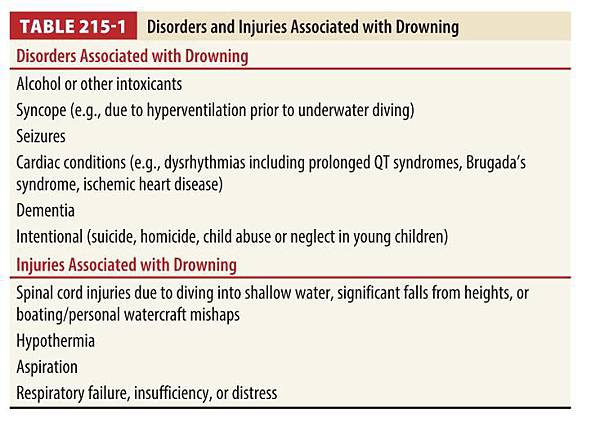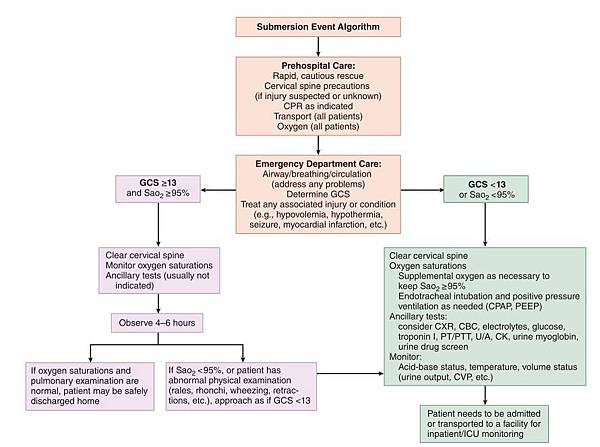Salt water drowning :
Hypertonicity of salt water leads to pulmonary edema and hypertonic serum
Fresh water drowning :
Aspirated hypotonic fluid leads to volume overload and dilutional effects on serum electrolytes
但其實要喝很多才會發生體液和電解質改變
Aspiration > 11 mL/kg of body weight must occur before blood volume changes occur
and > 22 mL/kg before electrolyte changes take place
平均才喝 3 to 4 mL/kg
所以區分鹽水淡水已經 no longer considered important
Both nonfatal drowning 都是造成
Decreased lung compliance
Ventilation-perfusion mismatching
Intrapulmonary shunting
leading to hypoxemia that causes diffuse organ dysfunction ~
Pulmonary
Fluid aspiration water wash out surfactant
noncardiogenic pulmonary edema + ARDS
Neurologic
Hypoxemia and ischemia cause neuronal damage
cerebral edema and elevations in intracranial pressure
Cardiovascular
Arrhythmias secondary to hypothermia and hypoxemia
Acid-base and electrolytes
A metabolic and/or respiratory acidosis is often observed.
Significant electrolyte imbalances generally do not occur
Renal
Renal failure rarely can occur after submersion,
is usually due to acute tubular necrosis resulting from hypoxemia, shock
Management : Prehospital
- CPR
- Ventilation is the most important initial treatment
- Cervical spinal cord injury 不常見
除非機轉 (dive into shallow water) or clinical signs 懷疑
常規 cervical spine immobilization 反而干擾 airway management
- Drowning patients can present with life-threatening arrhythmias
- The Heimlich maneuver or other postural drainage techniques
to remove water from the lungs are of no proven value.
- High-flow supplemental oxygen by facemask for spontaneously breathing patients
Apneic patient : intubation
- Rewarming hypothermic patients if core temperature < 33ºC
All patients with drowning amnesia for the event, loss of or depressed consciousness,
or an observed period of apnea, as well as those who require a period of artificial ventilation,
should be transported to an ED for evaluation, even if they are asymptomatic at the
scene.
Management : ER
Assess and secure the airway, provide oxygen
Determine core temperature, and assist ventilation as necessary
Indications for intubation :
- Signs of neurologic deterioration or inability to protect the airway
- Inability to maintain a PaO2 > 60 mmHg or SpO2 > 90% despite high-flow supplemental oxygen
- PaCO2 above 50 mmHg
至少 Keep SpO2 > 94%, BiPAP 有幫助
Trauma evaluation 要做, C spine injury 不常見但仍要懷疑
Passive and active external rewarming
3 管 Cardiac enzyme, ABG, CXR, ECG, Toxic screen, alcohol
Asymptomatic patients should be closely observed for approximately 8 hrs and admitted if any deterioration occurs.
完全沒症狀也要觀察 8hrs
有症狀就是直接住院
Aspiration is common 但 antibiotics prophylaxis 不一定需要, 視情況看水質
Neurologic injuries
Prevent secondary neurologic injuries due to ongoing ischemia,
cerebral edema, hypoxemia, fluid and electrolyte imbalances,
acidosis, and seizure activity.
- 頭高 30 度
- Diuretics can be used to avoid hypervolemia
- Hyperventilation
- Seizure
Respiratory failure or infection
Bronchospasm is often seen in nonfatal drowning victims,
and management is treated similarly to acute asthma; most cases rapidly improve with inhaled beta agonists.
No high-quality evidence that pulmonary function improves with surfactant therapy
Mechanical ventilation + ECMO
Outcome
Poor prognosis if :
- Duration of submersion > 5 mins (most critical factor)
- Time to effective basic life support > 10 mins
- Resuscitation duration > 25 mins
- Age >14 years
- GCS < 5 (comatose)
- Persistent apnea and requirement of CPR in the ED
- Arterial blood pH <7.1 upon presentation


- Uptodate : https://www.uptodate.com/contents/drowning-submersion-injuries#H12
- Tintinalli chaper 215


 留言列表
留言列表


